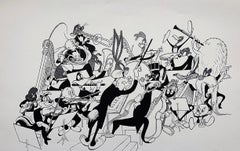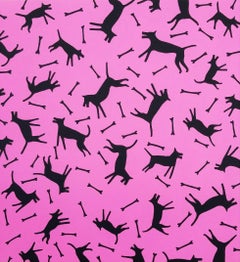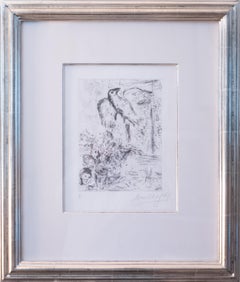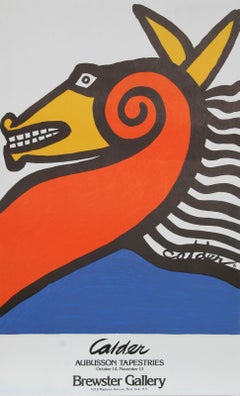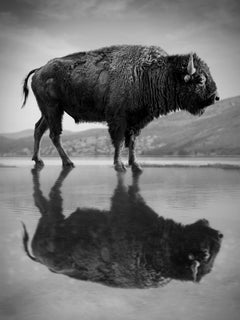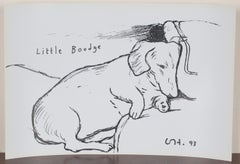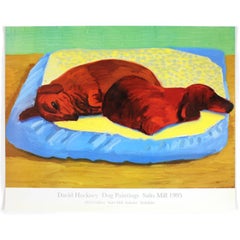Animal Prints
to
725
3,323
970
1,214
534
552
Overall Width
to
Overall Height
to
1,971
1,388
400
287
222
154
119
79
39
39
33
13
12
4
197
169
104
101
77
696
1,435
2,627
1,841
35
30
66
163
100
145
248
637
355
316
663
3,416
2,770
368
2,722
1,767
1,458
1,084
869
544
502
449
440
398
360
357
329
246
229
186
175
148
142
141
2,237
1,536
1,248
686
519
761
2,608
3,199
2,006
Animal Prints For Sale
Dogs and Bones /// Contemporary Pop Art Animal Pet Funny Humor Screenprint
By Dan May
Located in Saint Augustine, FL
Artist: Dan May (American, 1955-)
Title: "Dogs and Bones"
*Signed and numbered by May in pencil lower left
Year: 1986
Medium: Original Screenprint on unbranded white wove paper
Limited edition: 15/25
Printer: the artist May himself, Oakland, CA
Publisher: the artist May himself, Oakland, CA
Sheet size: 34.13" x 29.88"
Image size: 25.88" x 24"
Condition: Some moderate edge wear around, and heavy wear with a repaired tear at lower right corner. In otherwise good condition with strong colors and clean paper. Will look great once framed and with its marginal imperfections covered
Notes:
Titled and dated by May in pencil lower right.
Biography:
Dan May is an American painter and printmaker born on March 11, 1955 in San Francisco, CA. Raised in aesthetic surroundings heavily influenced by his architect father, May grew up learning to view all things with an eye for design, color, and shape. At age 5, he remembers his father cutting up a book of drawings by Henri Matisse and hanging them on the walls of their home. The French master Matisse as well as Richard Diebenkorn and David Hockney are his favorite art influences. He began his first attempts at painting at age 15, and later began to experiment with printmaking, teaching himself various techniques such as woodblock printing, etching, silkscreen printing, and monoprinting.
Monoprinting soon became May's medium of choice due to its wide range of expression and spontaneity that he felt other techniques lacked. May - "With monoprinting, you can only work a piece for as a long as the paint stays wet, so the resulting print has a feeling of movement and immediacy. I also like how monoprinting allows the brush strokes to transfer a transparent light quality to the print. For me, this is a technique that bridges drawing...
Category
1980s Contemporary Animal Prints
Materials
Screen
"Old World" 60x40 Black & White Photography Bison Buffalo Signed Photograph
Located in Los Angeles, CA
This is a contemporary photograph of an American Bison.
Printed on archival paper and using archival inks
Framing available. Inquire for rates.
Signed edition of 10
Shane Russeck...
Category
21st Century and Contemporary Animal Prints
Materials
Archival Pigment
$1,240 Sale Price
20% Off
Madoura, Colorful Bird - Original lithograph poster (Czwiklitzer #319)
Located in Paris, IDF
Pablo PICASSO (1881-1973)
Madoura, Colorful Bird, 1967
Lithograph poster (Mourlot workshop)
On paper 67 x 48 cm (c. 27 x 19 in)
Lilmited edition of 1000 proofs (unumbered)
REFERENC...
Category
1960s Modern Animal Prints
Materials
Lithograph
Little Boodge
Located in Manchester, GB
David Hockney, Little Boodge, 1993
Offset lithograph on paper
28 x 42 cm (11 × 16 1/2 in)
Signed and dated in plate, recto
Based upon Hockney's beloved miniature dachshund Boodge...
Category
1990s Contemporary Animal Prints
Materials
Lithograph
Dog 43
Located in Manchester, GB
David Hockney, Dog 43, 1995
Original vintage exhibition posters from 1995 featuring Hockney's paintings of his beloved dachshunds, Stanley and Boodge, that appeared in many of his p...
Category
1990s Contemporary Animal Prints
Materials
Lithograph
Rhinoceros, Tribute to Albrecht DURER - Lithograph poster SIGNED (Gaspar #1503)
Located in Paris, IDF
Salvador Dali (1904-1989)
Rhinoceros, Tribute to Albrecht DURER, 1971
Original lithograph
Hand Signed in pencil
Numbered / 300
On Guarro vellum 76 x 56.5 cm (c. 30 x 22 in)
REFEREN...
Category
1970s Surrealist Animal Prints
Materials
Lithograph
Once Upon a Time in the West - 40x 80 Photography of Wild Horses - Mustangs
Located in Los Angeles, CA
This is a contemporary photograph of a American Wild Mustang.
"They represent the ultimate expression of American freedom"
40x80
Unsigned print
Printed on archival papers using ar...
Category
21st Century and Contemporary Animal Prints
Materials
Archival Pigment
Picasso, Le Chat, Histoire naturelle (after)
Located in Auburn Hills, MI
Lithograph on papier bouffant des Papeteries de Casteljoux paper. Unsigned and unnumbered, as issued. Good condition. Notes: From the folio, Eaux-fortes originale pour des textes de ...
Category
1970s Modern Animal Prints
Materials
Lithograph
$716 Sale Price
20% Off
Original Antique English Dog Picture Head Portrait in Gilt frame
Located in Cirencester, Gloucestershire
Head Portrait of a Dog
English School, 19th century
oleograph on paper on board, framed glass covered
framed: 13 x 11.5 inches
board: 9.5 x 8 inches
Provenance: private collection, E...
Category
19th Century Victorian Animal Prints
Materials
Digital
Picasso "Toros & Toreros" Photolithography
Located in Cuauhtemoc, Ciudad de México
This framed Picasso print, is an offset lithographic book plate from a captivating book, entitled Toros y Toreros (Bulls and Bullfighters), which features the iconic artwork of Pablo...
Category
Mid-20th Century Cubist Animal Prints
Materials
Lithograph
$480 Sale Price
60% Off
Picasso "Toros & Toreros" Photolithography
Located in Cuauhtemoc, Ciudad de México
This framed Picasso print, is an offset lithographic book plate from a captivating book, entitled Toros y Toreros (Bulls and Bullfighters), which features the iconic artwork of Pablo...
Category
Mid-20th Century Cubist Animal Prints
Materials
Lithograph
$560 Sale Price
53% Off
LOBSTER and OCTOPUS (KAMPF - BATTLE)
Located in Santa Monica, CA
NORBERTINE VON BRESSLERN-ROTH (1891 1978)
KAMPF (BATTLE - LOBSTER and OCTOPUS) c. 1928
Color linoleum cut Signed in pencil. Image 8 5/8 x 8 11/16”
In excellent condition and full ...
Category
1920s Vienna Secession Animal Prints
Materials
Linocut
"Sea Wolf" 30x60, Black and White Wolf, Wolves, Photography Photograph Art
Located in Los Angeles, CA
This is a contemporary black and white photograph of a Costal Wolf.
Printed on archival paper using only archival ink.
Edition of 50
Singed and numbered
Framing available. Inquire ...
Category
21st Century and Contemporary Animal Prints
Materials
Archival Pigment
Better Together
Located in New York, NY
Sila Sehrazat Yucel is a talented artist based in Istanbul. Her background in landscape and interior architecture shapes her creative vision. With experience as an art director in ci...
Category
2010s Contemporary Animal Prints
Materials
Archival Pigment
The Vitraux : Giraffe Afire - Original Lithograph Handsigned
Located in Paris, IDF
Salvador DALI
The Vitraux : Giraffe Afire, 1973
Original lithograph
Handsigned in pencil
Numbered edition of 250 copies
On Arches vellum, 48 x 65 cm (c. 18.9 x 25.6 inch)
Refere...
Category
1970s Animal Prints
Materials
Lithograph
untitled (horseman)
Located in Palm Springs, CA
This whimsical and surreal etching by Mexican artist Maximino Javier, dated 1984, embodies his unique visual language that blends fantasy, folklore, and satire. Executed with intrica...
Category
1980s Contemporary Animal Prints
Materials
Etching
Bible : Simeon, Angels and Red Birds - Lithograph (Mourlot 1962)
By Marc Chagall
Located in Paris, IDF
Marc CHAGALL (1887-1985)
Bible : Simeon, Angels and Red Birds, 1962
Lithograph (Mourlot workshop)
Unsigned
On Vellum 32.5 x 24 cm
INFORMATION: Lithograph produced by Chagall in 196...
Category
1960s Modern Animal Prints
Materials
Lithograph
Borzoi, Sealyham, Collie, Cecil Aldin 1930s dog lithograph
Located in Melbourne, Victoria
'Borzoi, Sealyham, Collie'
Cecil Aldin dog lithograph, 1935.
Cecil Aldin was a British artist and illustrator best known for his paintings and sketch...
Category
1930s English School Animal Prints
Materials
Lithograph
David Shrigley - Old Cat (I Still Love You), 2022
Located in Central, HK
David Shrigley
Old Cat (I Still Love You), 2022
12 Colour Screenprint with a Varnish Overlay on Somerset Tub Sized 410gsm Paper
Edition of 125
Print Size: 76cm x 56cm
Signed and numb...
Category
2010s Animal Prints
Materials
Paper
Be Yourself Just Be Yourself
Located in Manchester, GB
David Shrigley, Be Yourself Just Be Yourself, 2025
22 colour screenprint with varnish overlay on Somerset Tub Sized 410 gsm paper
56 x 76 cm (22.04 x 29.92 in)
Edition of 125
Han...
Category
2010s Contemporary Animal Prints
Materials
Screen
Pablo Picasso (After), 'La Ronde de la Jeunesse', Lithograph, 1961
Located in Pembroke Pines, FL
Artist: PABLO PICASSO (AFTER )
Title: 'La Ronde de la Jeunesse (The Youth Circle)'
Year: 1961
Published by: Combat Pour La Paix, Paris
Medium: Lithograph on wove paper
Printed by Mourlot
Edition: 200 plus EA
Size: 26 x 20 inches
Signed and numbered in pencil by the master
CERTIFICATE OF AUTHENTICITY INCLUDED
ARTWORK IS IN EXCELLENT CONDITION
Through the use of crisp vibrant colors and the fluid use of line, Picasso creates a sense of optimistic energy that is focused around the dove of peace in Pablo Picasso La Ronde de la Jeunesse...
Category
1950s Contemporary Animal Prints
Materials
Lithograph
Pablo Picasso (After), 'La Colombe de L'avenir, 1962'
Located in Pembroke Pines, FL
Artist: PABLO PICASSO (AFTER )
Title: La Colombe de L'avenir
Year: 1962
Published by: Combat Pour La Paix, Paris
Medium: Lithograph on Rives BFK paper
Printed by Mourlot
Edition: 200...
Category
1960s Contemporary Animal Prints
Materials
Lithograph
I Will Not Allow The Dark Skies To Affect Me
Located in Manchester, GB
David Shrigley, I Will Not Allow The Dark Skies To Affect Me, 2025
22 colour screenprint with varnish overlay on Somerset Tub Sized 410 gsm paper
56 x 76 cm (22.04 x 29.92 in)
Edi...
Category
2010s Contemporary Animal Prints
Materials
Screen
Pablo Picasso (After), 'Vive le Paix (Long Live Peace) Lithograph, 1954
Located in Pembroke Pines, FL
Artist: PABLO PICASSO (AFTER )
Title: Vive le Paix (Long Live Peace)
Year: 1954
Published by: Combat Pour La Paix, Paris
Medium: Lithograph on Lana paper (Blind stamp JPG attached)
P...
Category
1950s Contemporary Animal Prints
Materials
Lithograph
David Shrigley - Thank You For Keeping Still, 2023
Located in Central, HK
David Shrigley
Thank You For Keeping Still, 2023
12 colour screenprint with a two varnish overlay printed on Somerset Satin Tub sized 410 gsm in a custom delivery box adorned with a ...
Category
2010s Animal Prints
Materials
Paper, Satin Paper
Monkeys, English antique animal engraving print, 1879
Located in Melbourne, Victoria
Monkeys
Wood-engraving with original colouring. 1879.
160mm by 245mm (sheet).
Key below the image. From Oliver Goldsmith's 'A History of the Earth and Animated Nature'.
Category
Late 19th Century Victorian Animal Prints
Materials
Engraving
Original New Orleans Jazz & Heritage Festival vintage poster
Located in Spokane, WA
Original, Linen backed New Orleans Jazz & Heritage Festival poster from 1983. A fun image with a crawfish holding an umbrella with streamers. 1983 JAZZ & HERITAGE FESTIVAL PRO-MO ...
Category
1980s American Modern Animal Prints
Materials
Offset
'Wading Egret' — Japanese Woodblock kacho-e
By Ohara Koson
Located in Myrtle Beach, SC
'Wading Egret', color woodblock, c. 1900 - 1910. Signed 'Koson' in black ink with the artist’s red seal beneath, lower left. A superb, skillfully-inked impression, with fresh colors,...
Category
Early 1900s Naturalistic Animal Prints
Materials
Woodcut
Salvador Dali - Flordali II, Butterfly Rose
Located in London, GB
Salvador Dali,
Flordali II, 1981
Lithograph on Arches vellum
Edition of 5000
103 x 73 cm
signed in the plate
Catalogue references: Field page 233 / Michler & Lopsinger 1586
This...
Category
1980s Surrealist Animal Prints
Materials
Lithograph
The Elephant (Untitled)
Located in Manchester, GB
David Shrigley, The Elephant, 2023
Screenprint in colours on wove paper
56 x 76 cm (22 x 29 9/10 in)
Edition of 125
Hand-signed and numbered on the reverse
David Shrigley
Briti...
Category
2010s Contemporary Animal Prints
Materials
Screen
Lines in Four Directions, Rubber Stamp Portfolio, Sol LeWitt
By Sol LeWitt
Located in Auburn Hills, MI
Printer’s ink from rubber stamp on vélin d’Arches Satine paper. Paper Size: 8 x 8 inches. Inscription: Unsigned, as issued. Notes: From the folio, Rubber Stamp Portfolio, 1977. Publi...
Category
1970s Minimalist Animal Prints
Materials
Printer's Ink
$5,996 Sale Price
20% Off
La Pique (I), from A Los Toros Avec Picasso
Located in Washington, DC
Artist: Pablo Picasso
Title: La Pique (I)
Portfolio: A Los Toros Avec Picasso
Medium: Transfer lithograph
Date: 1961
Edition: Unnumbered
Frame Size: 18 1/4" x 20 3/4"
Sheet Size: 9 1...
Category
1960s Cubist Animal Prints
Materials
Lithograph
Roy De Forest, Dog lithograph, signed/n by world renowned California pet painter
Located in New York, NY
Roy De Forest
Untitled (Dog), 1981
Color lithograph with deckled edges. Floated and framed.
Pencil signed and numbered from the edition of 125
Frame Included: held in original vintage white frame
Wonderful whimsical rare 1981 lithograph by the incredibly popular and beloved Roy de Forest, famous for his paintings and prints of dogs...
Category
1980s Surrealist Animal Prints
Materials
Lithograph
Keith Haring Tony Shafrazi gallery 1982 (set of 6 printed works)
By Keith Haring
Located in NEW YORK, NY
Keith Haring Tony Shafrazi 1982: set of 6 printed works:
A set of six, individual, double-sided lithographic inserts from the seminal, spiral bound 1982 Keith Haring Tony Shafrazi ca...
Category
1980s Pop Art Animal Prints
Materials
Lithograph, Offset
Captain
Located in New York, NY
ABOUT THIS PIECE: My artistic journey on Burano Island has been a captivating exploration of its vibrant character. While initially drawn to its clotheslines and colourful walls in search of inspiration for my next clothesline animal, I soon discovered that each whimsical house possessed its own unique personality. My work seeks to highlight and amplify these distinctive features, celebrating the island's charm beyond its iconic laundry, embracing the quirks and individuality of every little dwelling.
ABOUT THIS ARTIST: Helga Stentzel...
Category
2010s Animal Prints
Materials
Photographic Paper
Pablo Picasso ( 1881 – 1973 ) La Grande Maternité – hand-signed lithograph 1963
Located in Pembroke Pines, FL
After Pablo Picasso (Spanish, 1881-1973)
La Grande Maternité
1963
pencil signed and annotated 'E.A.' (aside from the edition of 200), with margins
Editions Combat de la Paix, Paris
P...
Category
1950s Contemporary Animal Prints
Materials
Lithograph
Cow (Feldman & Schellmann II.11), Andy Warhol
By Andy Warhol
Located in Auburn Hills, MI
Silkscreen in colours on wallpaper. Inscription: printed, “Andy Warhol” in margin, as issued. Excellent condition. Notes: Published by Leo Castelli Gallery, New York; printed by Bill...
Category
1960s Pop Art Animal Prints
Materials
Screen
$47,996 Sale Price
20% Off
David Shrigley - Preen Yourself
Located in Central, HK
David Shrigley
Preen Yourself, 2023
13 colour screenprint with a two varnish overlay printed on Somerset Satin Tub sized 410 gsm
29 1/2 × 22 in 75 × 56 cm
Signed by the artist and n...
Category
2010s Animal Prints
Materials
Paper, Satin Paper
A Los Toros Avec Picasso (Set of Three in Gold Frames)
Located in Washington, DC
Artist: Pablo Picasso
Title: La Pique (I), Jeu de la Cape (III), Les Banderilles (IV)
Portfolio: A Los Toros Avec Picasso
Medium: Set of three transfer lithographs
Date: 1961
Edition...
Category
1960s Animal Prints
Materials
Lithograph
24x36 Bison American Buffalo Photography Art Poster Print Fine Art Photogrtaph
Located in Los Angeles, CA
Museum quality archival exhibition poster print.
Dimensions: 24" x 36" sheet.
Photograph © Shane Russeck
Excellent condition (Brand new, never framed or displayed).
Category
21st Century and Contemporary American Modern Animal Prints
Materials
Archival Ink, Archival Pigment
The Patient Traveler, color limited edition photomontage artwork
Located in Sante Fe, NM
The Patient Traveler by Maggie Taylor is a limited-edition, color photomontage image.
Maggie Taylor is a Florida-based artist who creates complex photomontage compositions with a fl...
Category
2010s Animal Prints
Materials
Archival Pigment
Seals, English antique animal engraving print, 1879
Located in Melbourne, Victoria
Seals
Wood-engraving with original colouring. 1879.
160mm by 245mm (sheet).
Key below the image. From Oliver Goldsmith's 'A History of the Earth and Animated Nature'.
Category
Late 19th Century Victorian Animal Prints
Materials
Engraving
Ibiza Hound puppy, Cecil Aldin 1930s puppy dog lithograph
Located in Melbourne, Victoria
'Ibiza Hound puppy'
Cecil Aldin dog lithograph, 1935.
Cecil Aldin was a British artist and illustrator best known for his paintings and sketches of animals, sports, and rural life....
Category
1930s English School Animal Prints
Materials
Lithograph
Irish Wolfhound and Wire Haired Terrier, Cecil Aldin 1930s dog lithograph
Located in Melbourne, Victoria
'Irish Wolfhound and Wire Haired Terrier'
Cecil Aldin dog lithograph, 1935.
Cecil Aldin was a British artist and illustrator best known for his paintings and sketches of animals, s...
Category
1930s English School Animal Prints
Materials
Lithograph
Unicorn
Located in New York, NY
ABOUT THIS PIECE: My artistic journey on Burano Island has been a captivating exploration of its vibrant character. While initially drawn to its clotheslines and colourful walls in search of inspiration for my next clothesline animal, I soon discovered that each whimsical house possessed its own unique personality. My work seeks to highlight and amplify these distinctive features, celebrating the island's charm beyond its iconic laundry, embracing the quirks and individuality of every little dwelling.
ABOUT THIS ARTIST: Helga Stentzel...
Category
2010s Animal Prints
Materials
Photographic Paper
Cow (Feldman & Schellmann II.12), Andy Warhol
By Andy Warhol
Located in Auburn Hills, MI
Silkscreen in colours on wallpaper. Inscription: printed, “Andy Warhol” and “© Copyright Factory Additions 1971” in margins, as issued. Excellent condition. Notes: Published by Facto...
Category
1970s Pop Art Animal Prints
Materials
Screen
$39,996 Sale Price
20% Off
A Los Toros Avec Picasso (Set of Four in Gold Frames)
Located in Washington, DC
Artist: Pablo Picasso
Title: La Pique (I), Le Picador (II), Jeu de la Cape (III), Les Banderilles (IV)
Portfolio: A Los Toros Avec Picasso
Medium: Set of four transfer lithographs
Ye...
Category
1960s Abstract Animal Prints
Materials
Lithograph
Picasso, L'Autruche, Histoire naturelle (after)
Located in Auburn Hills, MI
Lithograph on papier bouffant des Papeteries de Casteljoux paper. Unsigned and unnumbered, as issued. Good condition. Notes: From the folio, Eaux-fortes originale pour des textes de ...
Category
1970s Modern Animal Prints
Materials
Lithograph
$716 Sale Price
20% Off
Mid Century Chevaux et Cavalières La Nuit Lithograph
By Hoi Lebadang
Located in Soquel, CA
Mid Century Nocturnal Horses with Riders Under Moonlight Lithograph Limited Edition
Compelling nocturnal lithograph of two women on horseback by ...
Category
1960s Abstract Impressionist Animal Prints
Materials
Paper, Lithograph
Mickalene Thomas, Portrait de Priscilla Le Petit Chien official COA S/N, Framed
Located in New York, NY
Mickalene Thomas
Portrait de Priscilla Le Petit Chien, 2012
Pigment print on 100% cotton rag paper
Edition 141/150
Frame included with official COA affixed to the back
Hand numbered ...
Category
2010s Realist Animal Prints
Materials
Laid Paper, Permanent Marker, Digital Pigment
Butterflies, late 19th century antique natural history colour lithograph
Located in Melbourne, Victoria
'1. 2. Charaxes tiridates 3. Charaxes etheocles'
Late 19th century colour lithograph of butterflies.
Category
Late 19th Century Victorian Animal Prints
Materials
Lithograph
Original Carthusia Capri - Italy, perfume vintage poster
Located in Spokane, WA
Original vintage poster Carthusia Capri (Italy) perfume vintage poster. Artist: Mario Laboccetta. "CARTHUSIA I PROFUMI DI CAPRI" Size 26.5" x ...
Category
1960s American Impressionist Animal Prints
Materials
Offset
Rooster Totem (Unframed)
Located in Philadelphia, PA
This piece titled "Rooster Totem" is an original artwork made from Letterpress, coque feather, mixed media by Katie VanVliet. This piece is shipped in the pictured white frame and me...
Category
21st Century and Contemporary Contemporary Animal Prints
Materials
Found Objects, Mixed Media, Color
Mid-Century Original Printed Menu, Transatlantic French Line, 'Ile de France'.
Located in Cotignac, FR
Mid-century French transatlantic liner menu with printed illustration by French artist Jean Adrien Mercier. Signed in the print, top left and dated 1956 inside centre.
This highly c...
Category
Mid-20th Century Modern Animal Prints
Materials
Paper, Printer's Ink
"Old World" 60x40 Black & White Photography Bison Buffalo Unsigned Photograph
Located in Los Angeles, CA
This is a contemporary photograph of an American Bison.
Printed on archival paper and using archival inks
Framing available. Inquire for rates.
Shane Russeck has built a reputati...
Category
21st Century and Contemporary Animal Prints
Materials
Archival Pigment
"Cheetah (black & white)"
Located in North Adams, MA
"Cheetah (black & white)," Amir Akhavan, 2017
Silkscreen and iridescence on 290 gram Coventry Rag paper
Dimensions: 25" x 19.25"
Signed and numbered by the Artist in pencil
An editio...
Category
21st Century and Contemporary Contemporary Animal Prints
Materials
Screen
Walasse Ting Grasshoppers 1981 Lithograph on Arches Archival Paper
By Walasse Ting
Located in Rochester Hills, MI
Walasse Ting
Grasshoppers - 1981
Print - Lithograph on Arches Archival Paper 22'' x 30''
Edition: Signed in pencil and marked 170/200
Walasse Ting (DING XIONGQUAN) (October 13, 19...
Category
1980s Pop Art Animal Prints
Materials
Lithograph
80x40 King of the Mountain Black and White Photography, Cougar, Mountain Lion
Located in Los Angeles, CA
This is a contemporary photograph of a Mountain Lion.
80x40 Edition of 5.
Singed and numbered by Shane on the bottom corners
Printed on archival paper using archival inks
Framing ...
Category
21st Century and Contemporary Animal Prints
Materials
Archival Pigment
Torro Negro, Painting, Pop Art, Street Art, Black bull
By Jay-C
Located in München, BY
Edition 5
Portrait oof a black bull with Basquiat crown
JAY-C – the pseudonym of this innovative young artist known for his subversive use of familiar figures and symbols. Using a d...
Category
2010s Pop Art Animal Prints
Materials
Mixed Media, Pigment, Archival Pigment
I've Got Your Lipstick - Contemporary Art
Located in London, GB
Screenprint in colours
76 x 56 cm
Edition 72 of 125
published by DDT, comes with COA
David Shrigley is known for his distinctive and darkly humorous drawings, animations, and sculp...
Category
2010s Contemporary Animal Prints
Materials
Screen
Recently Viewed
View AllMore Ways To Browse
Le Singe Et Le Leopard
Leon Cauvy
Leon Danchin On Sale
Leroy Neiman Hunt
Manetti Saverio
Peter Klucik
Picasso Farol
Rob Pruitt Panda
Salvador Dali Argus
Salvador Dali Unicorn
Sam Savitt
Sussex Spaniel
Szabolcs Bozo
Tauromaquia Picasso
Vintage Posters Coppertone
Warhol Orangutan
Warhol Purple Cow
Warhol Siberian Tiger

